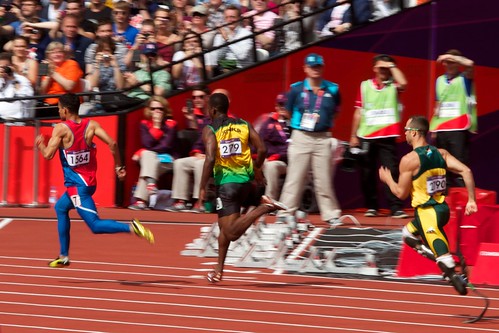South African sprinter Oscar Pistorius just made history as the first double amputee to participate in the Olympic games, and the first amputee to take part in track events. Born without fibulae, Pistorius had his legs amputated below the knee before he was a year old.
Hugh Herr is an associate professor at the MIT Media Lab. An avid mountain climber, as a teenager he was caught in a blizzard while climbing in New Hampshire. After spending three nights outside in below-zero temperatures, he suffered severe frostbite and had to have both legs amputated below the knees. Not only did he walk again, he began climbing again using self-designed prostheses. [At left, Herr on the climbing wall at the Lab's h20 event. Photo: Webb Chappell]
Herr was an expert witness in the court case that resulted in the reversal of the ban preventing Oscar Pistorius from competing in the Olympics. We asked him a few questions about the science behind how Oscar runs.
What kinds of challenges does Oscar Pistorius have to overcome when racing with prosthetic legs?
Hugh Herr (HH): Oscar faces three dominant problems when racing with the Cheetah prosthesis. First, the Cheetah springs are passive, and therefore do not change stiffness during a running step. Consequently, Oscar's vertical ground forces are compromised, negatively impacting his running speed—that is, he can't push off the ground as hard, which reduces how fast he can run.
Second, Oscar's passive prostheses only return the energy that Oscar puts into them, actually less energy due to hysteresis. In contrast, the human ankle-foot complex is muscle powered and thus can propel a runner forward out of the running blocks during the acceleration phase of a race. Although the acceleration phase of the race has never been studied, it's likely that Oscar suffers from a lack of ankle power during this period of the race.
Finally, Oscar's prostheses are attached to his residual limb using a prosthetic socket that can often be uncomfortable and unstable. When Oscar sweats, his biological leg would become attached less securely to the artificial leg, possibly causing a degradation of performance.
How are ‘Cheetah blades’ different from other types of prosthetics? How do they work?
HH: The Cheetah prosthesis is designed specifically for running, and not for other activities such as walking. The Cheetah is shaped like a 'C' and is made from carbon composite, a highly elastic material for storing and releasing spring energy.
Do you think we’ll see other athletes like Oscar competing in the Olympic Games moving forward?
HH: Other persons with leg amputations may qualify for the Olympic games in the future, but it may be a very long time before another athlete is capable of qualifying. Oscar is a gifted and tenacious athlete.

Oscar Pistorius runs in the 2012 Summer Olympics. Photo: Paul Williams | CC BY-ND 2.0
What other kinds of prosthetics are being developed at the Media Lab?
HH: The Media Lab's Biomechatronics group designs computer-controlled bionic limbs for walking and running. A recent invention is a powered ankle-foot bionic limb that has been shown to normalize the biomechanics and energetics of walking. [At left, Herr with a variety of prototyped prosthetics. Photo: Webb Chappell]



No comments:
Post a Comment